My first visit to Eze truly amazed me. As a young teenager, I remember the breathtaking view of the perched village overlooking the blue Mediterranean Sea. Indeed, the hilltop village commands stunning views of mountains falling to the Mediterranean. With its clusters of houses perched on rocky outcrops above the cliffs, Èze truly is one of the most celebrated resorts on the French Riviera. I am pleased to present a guide to the medieval village. If you have additional information to add to this post, please comment at the bottom of the article.
Watch our short video on the French Riviera, an aerial journey from Toulon to Menton via Saint-Tropez, Cannes, Nice and Monaco ⤵
Plan your trip to Eze and its surroundings!
- 🏨 Find the best accommodations in Eze and the region on Booking.com
- 🙋♀️ Get the PASS CÔTE D’AZUR and take your pick from more than 100 amazing experiences!
- 🌴 Read our Discovery Guides of La Turbie, Menton, Monaco, Peille and Peillon.
- 🎯 Take a guided hidden gem tour of Monaco
- 🥗 Experience the culture and food of Old Nice on a 4-hour sightseeing and tasting tour
- 📚 Read the DK Eyewitness Provence and the Côte d’Azur Travel Guide
- 🤩 Get familiar with the French Riviera
- 🗺 Download the touristic map of Eze (in Jpg)
- 🚻 Public toilets are located near the town hall (Mairie & Post Office) and near the church of Notre-Dame de l’Assomption.
- 🚗 Park at the entrance to the old medieval centre: Place Fighiera or Place de la Colette (Paid parking).
![Èze © Jean Pierre Lozi - licence [CC BY-SA 3.0] from Wikimedia Commons](https://frenchmoments.eu/wp-content/uploads/2014/08/Èze-©-Jean-Pierre-Lozi-licence-CC-BY-SA-3.0-from-Wikimedia-Commons.jpg)
Situation of Eze
Eze occupies a beautiful site between Nice and Monaco. The village lies on the Corniche Roads at an altitude of 426 m above sea level. You’ll find the entrance to the hilltop village itself on the Moyenne Corniche (D6007).
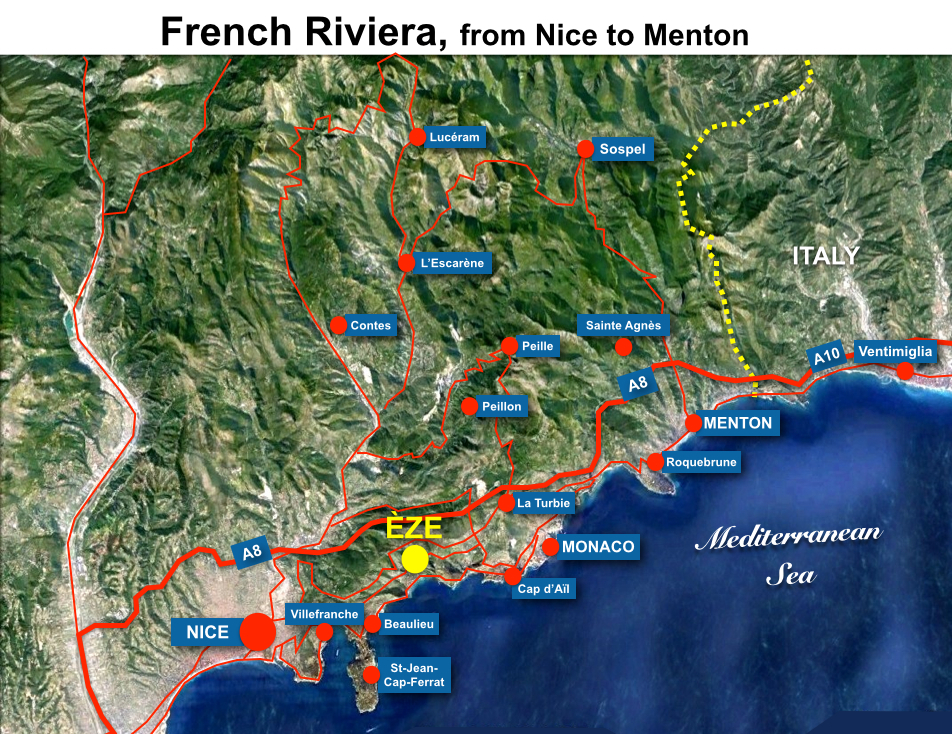
The view of Eze is most surprising when coming from the M6007 road in Nice. You can see the ruined castle on its eagle’s nest. Then a tunnel cut into the rock leads to a viaduct you must cross before arriving in the village.
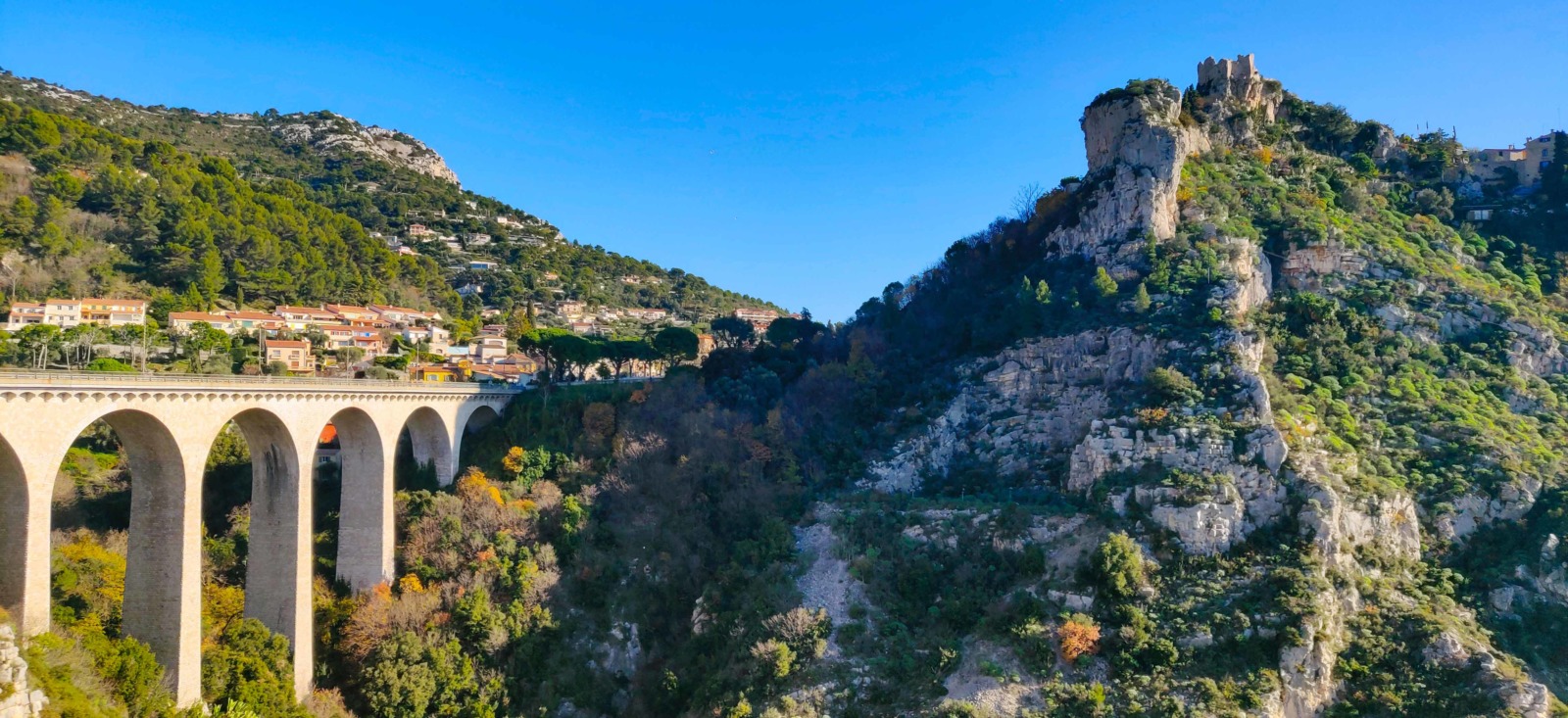
The people of Eze
The population amounts to approximately 3,000 residents called Ézasques.
Eze has welcomed several celebrities since the last century: Charlie Chaplin, Francis Blanche, Bono, Walt Disney, Princess Antoinette of Grimaldi…
It was in Eze that The Edge, lead guitarist of the band U2, got married in 2002.
The three areas of Eze
The commune of Eze is made up of three main urban areas:
- The perched village to the hilltop,
- Èze-sur-Mer on the Mediterranean coast,
- And between them, a residential zone with villas called Saint-Laurent-d’Èze.
The palindrome of Eze
Curiously, along a few other towns and villages, Èze forms a palindrome, ie. a name that reads the same forward or reversed:
- Callac (Côtes-d’Armor),
- Laval (Mayenne),
- Noyon (Oise),
- Sarras (Ardèche),
- Senones (Vosges),
- and Serres (Hautes-Alpes).
![Èze © Geir Hval - licence [CC BY-SA 4.0] from Wikimedia Commons](https://frenchmoments.eu/wp-content/uploads/2014/08/Èze-©-Geir-Hval-licence-CC-BY-SA-4.0-from-Wikimedia-Commons.jpg)
The motto of Eze
The motto of Èze is “Isis Moriendo Renascor” (in death, I am reborn), and its emblem features a phoenix perched on a bone.
Eze: a bit of History
![Èze © Toby 87 - licence [CC BY-SA 3.0] from Wikimedia Commons](https://frenchmoments.eu/wp-content/uploads/2014/08/Èze-©-Toby-87-licence-CC-BY-SA-3.0-from-Wikimedia-Commons.jpg)
The Ancient Times
It is believed that Celtic-Ligures tribes first populated the surroundings of Èze around 2000 BC. The oldest traces of human occupation were found in Mont-Bastide to the west of the hilltop village. The Romans later colonised the region. The first mention of the site dates back to the 2nd century, in the itinerary of Antonin.
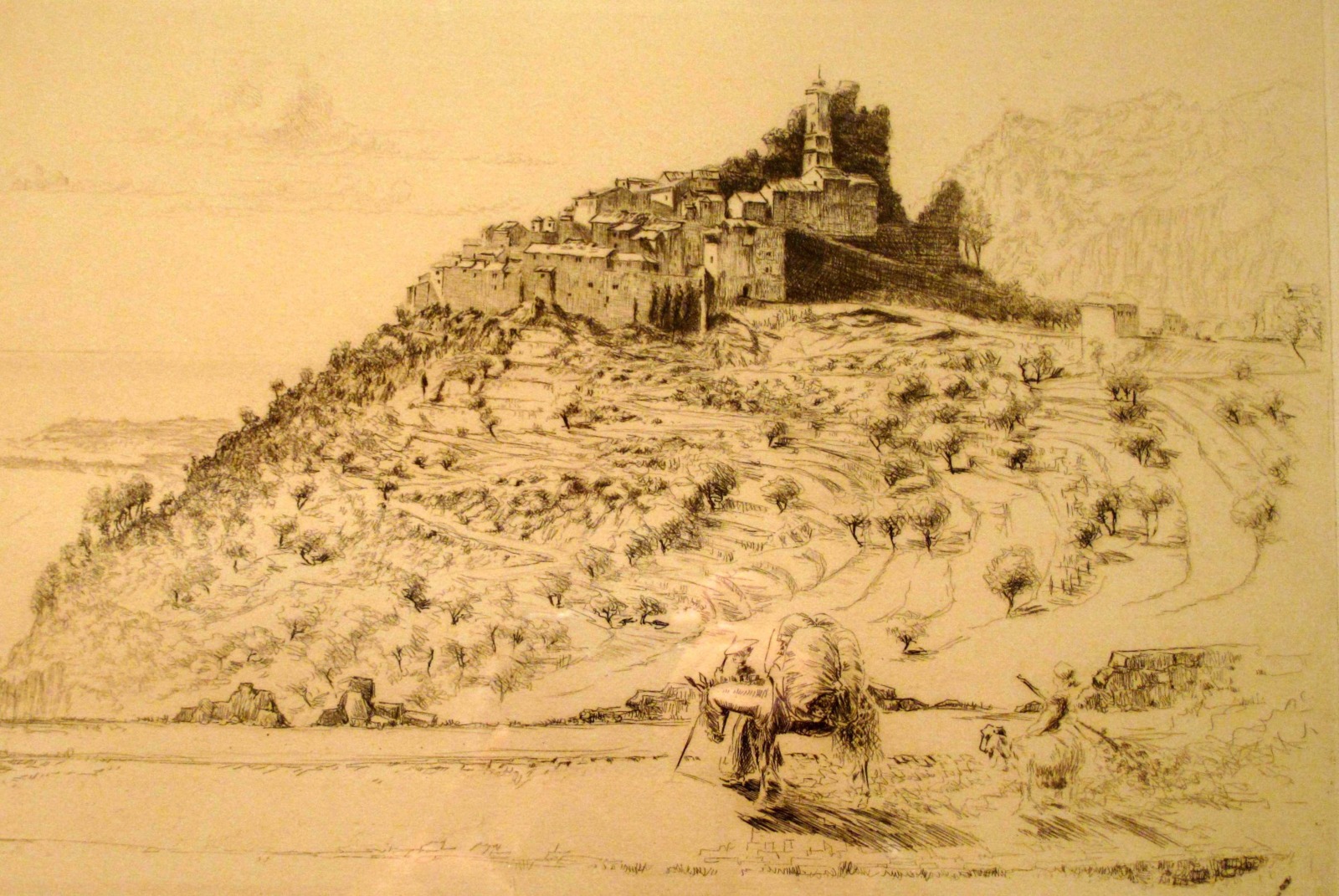
In the Middle Ages
In the 8th century, the coastal region was unsafe for the population who preferred to seek refuge in the rocky spur that now occupies the hilltop village. The threat was the Moors, who occupied Èze for some 80 years before William of Provence chased them in 973.
In 1388, Èze and the County of Nice became a possession of the House of Savoy.
The village’s proximity to Nice and its strategic eagle’s nest position commanding a fair view over the Mediterranean coastline brought the village a few difficult times.
For example, in 1543, French and Turkish troops seized Èze under the command of Barbarossa. French king François I and his ally Soliman the Magnificent were waging war against Charles V and the House of Savoy.
The modern era
Then in 1706, Louis XIV ordered the dismantling of its fortifications and castle during the War of the Spanish Succession, along with the castle of Nice.

After the Napoleonic Wars, Eze became part of the Kingdom of Piedmont-Sardinia.
In 1860, Èze unanimously voted for its annexation to France by referendum, as did the whole County of Nice.
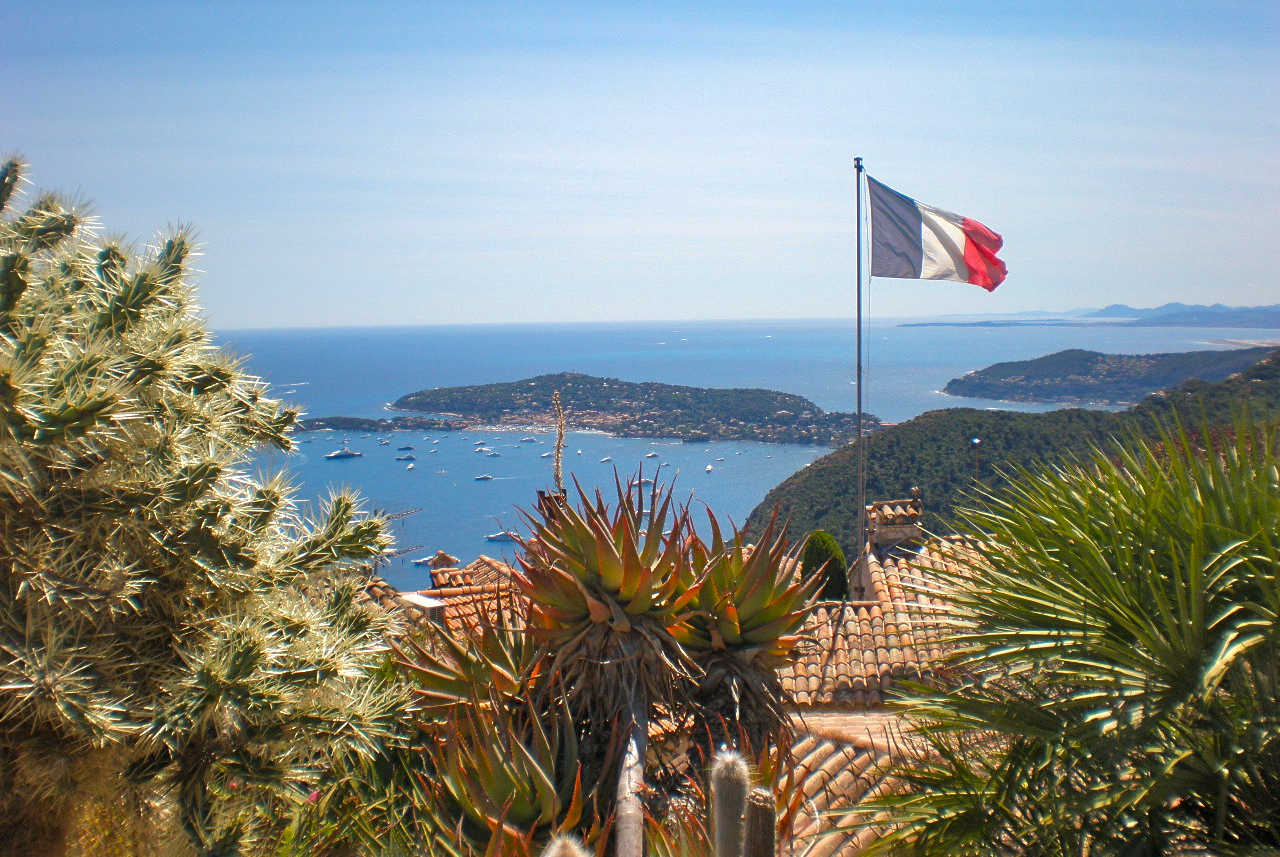
The village started to become a tourist attraction with the arrival of the railway between Nice and Menton.
The hilltop village of Èze
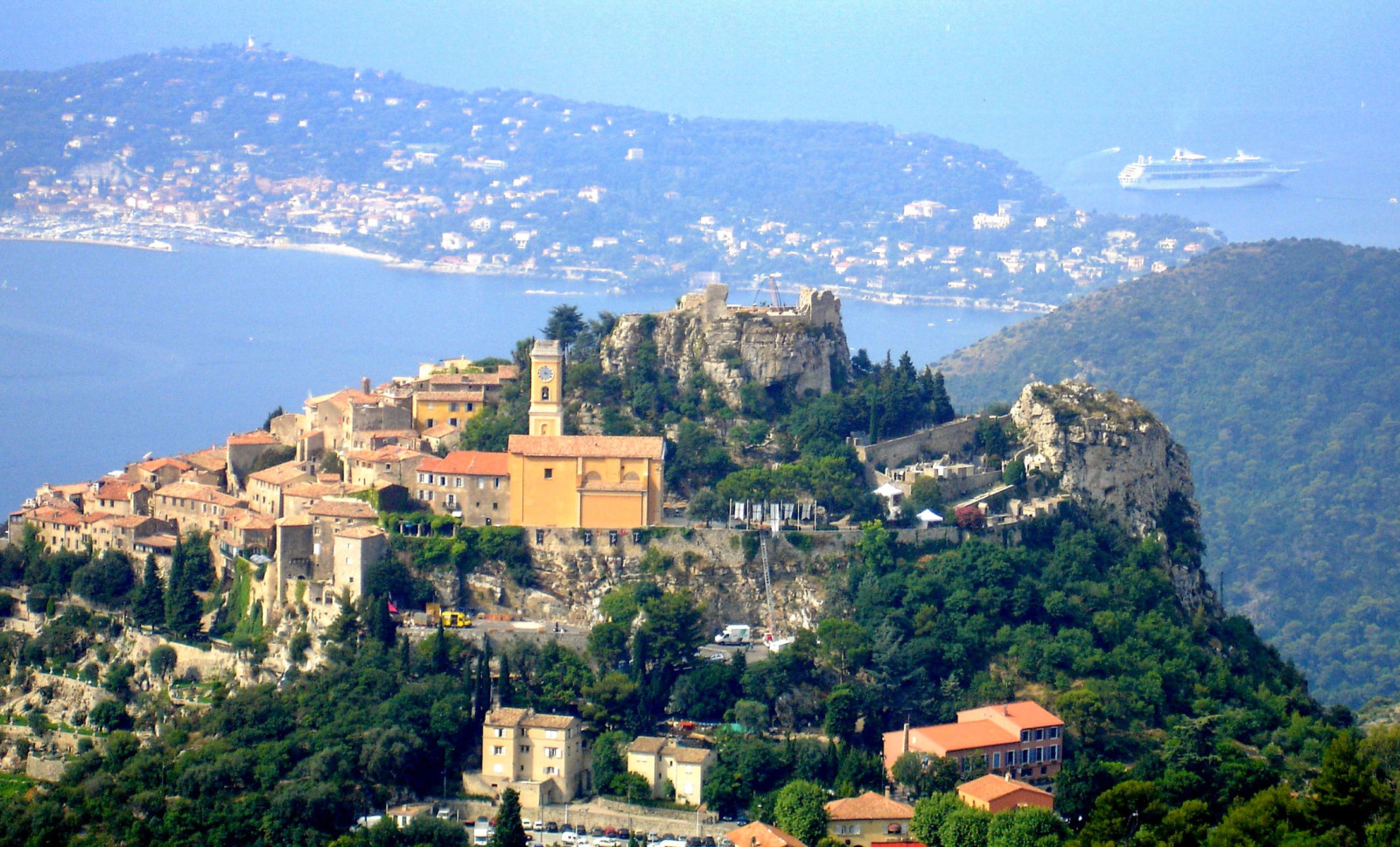
French writer George Sand put it nicely when describing Eze:
“It is really an enchantment the panorama of the corniche… The curves of the coast offer at each step a splendid background. The ruins of Eze, planted on a cone-shaped rock, with a picturesque village perched on a sugar loaf, stop the glance inevitably. This is the most beautiful point of view of the road, the most complete, the best composed. At the foreground there is the tremendous opening of mountains that open to let appear the Saracen fortress at the bottom of an abyss dominating another abyss.“
La Poterne: the entrance to Eze
To enter the historic village, go under the double fortified gate of “La Poterne”.
![Eze's Poterne gateway © Abxbay - licence [CC BY-SA 4.0] from Wikimedia Commons](https://frenchmoments.eu/wp-content/uploads/2014/08/Eze-gateway-©-Abxbay-licence-CC-BY-SA-4.0-from-Wikimedia-Commons.jpg)
The Counts of Savoy built it in the 14th century as part of their plans to improve the fortifications of Èze. This was the unique access to the village during the Middle Ages.
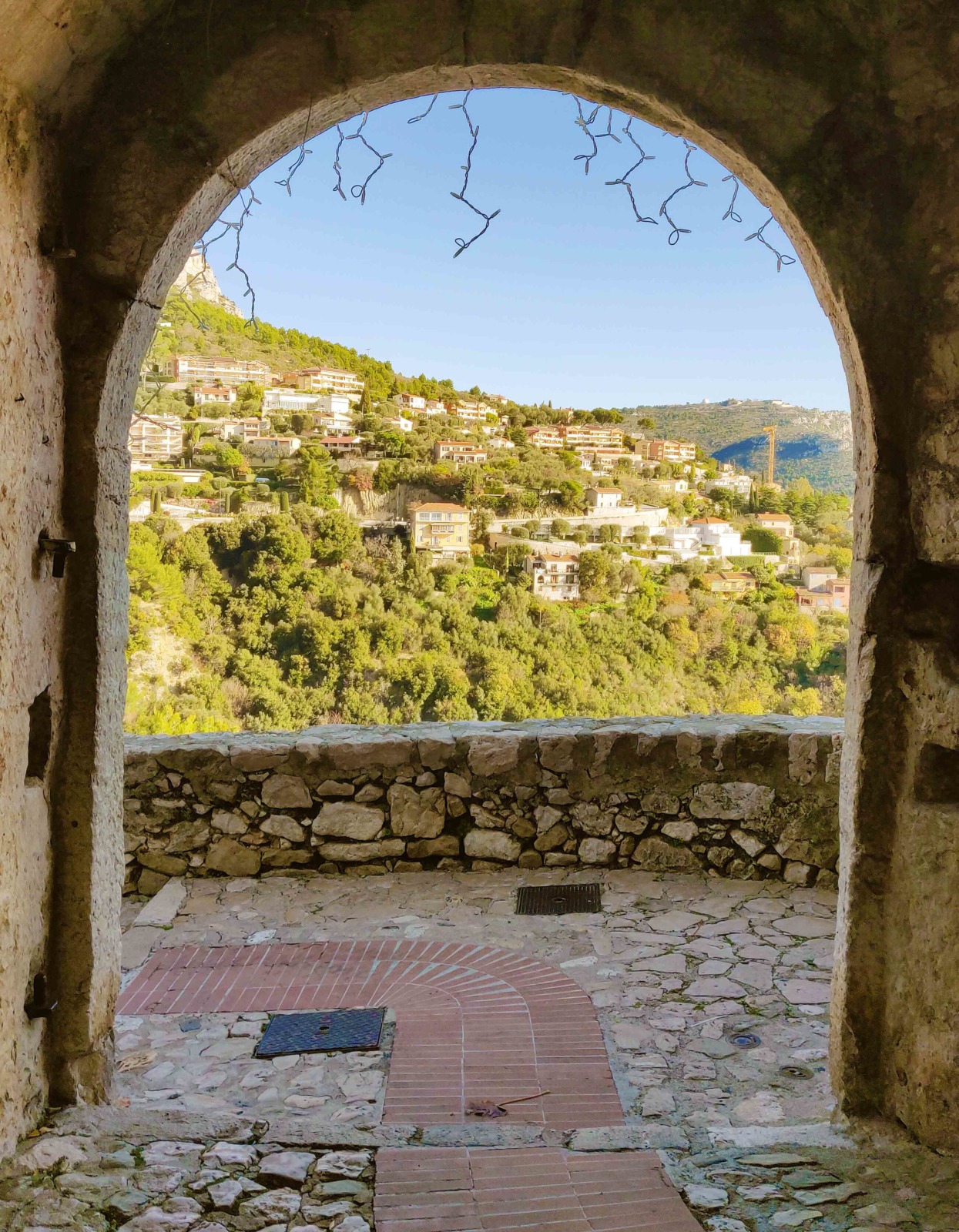
A museum-village?
Unlike villages like Sainte-Agnès or La Turbie, Èze has sometimes been described as a “Museum-Village” (Musée-Village) as only a few people of local origin reside within the walls of the old perched village. I learnt that approximately 20 people live permanently there, although I don’t know if this is true…
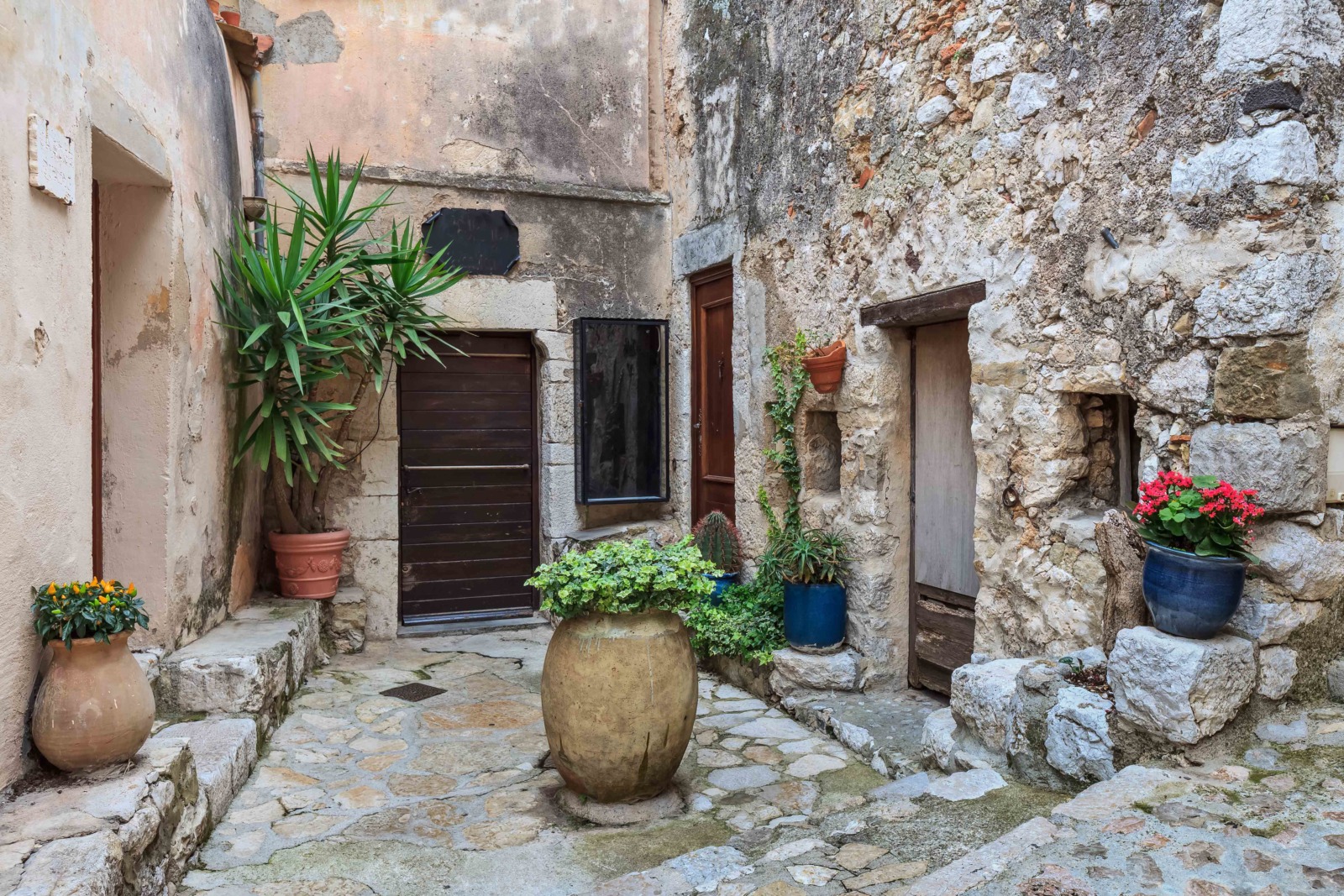
Anyway, many gift shops, art galleries, and restaurants cater for tourists and therefore might repel some of them from looking for more off-the-beaten-path sites (if this is the case, I recommend visiting Peillon, another hilltop village).
However, the charms of the village are undeniable, particularly when you (can) avoid the high summer season. Indeed, the village welcomes between 1000 and 1500 visitors per day on average.
Whatever the season of your visit, the views from Eze will amaze you. Above the lofty cliffs, the panoramic and stunning views of the Mediterranean Sea are unforgettable.
![The rooftops of Eze © avu-edm - licence [CC BY 3.0] from Wikimedia Commons](https://frenchmoments.eu/wp-content/uploads/2014/08/Eze-Roofs-©-avu-edm-licence-CC-BY-3.0-from-Wikimedia-Commons.jpg)
The calades of Eze
Once through the gate, you reach the small square of La Placette. From here, two streets start:
- The one that goes down is Rue du Barri and joins Rue du Malpas.
- The one that goes up is the Rue Principale. You must take this street to go up to the castle.
The old village comprises narrow, winding little streets punctuated by shady small squares and vaulted passages. In Provence, people call them “les calades“.

They lead to the rocky spur, crowned with the ruins of the 12th-century castle and a fine exotic garden.
At the bend in the streets, you will notice the shops set in old cellars or stables.
![Eze © jimmyweee - licence [CC BY 2.0] from Wikimedia Commons](https://frenchmoments.eu/wp-content/uploads/2014/08/Eze-©-jimmyweee-licence-CC-BY-2.0-from-Wikimedia-Commons-1.jpg)
Walking through the old village, you will discover luxuriant vegetation of date palms and orange, lemon, carob and banana trees.
![An old street in Eze © Abxbay - licence [CC BY-SA 3.0] from Wikimedia Commons](https://frenchmoments.eu/wp-content/uploads/2014/08/Eze-street-©-Abxbay-licence-CC-BY-SA-3.0-from-Wikimedia-Commons-1.jpg)
![Eze - A shady courtyard © avu-edm - licence [CC BY 3.0] from Wikimedia Commons](https://frenchmoments.eu/wp-content/uploads/2014/08/Eze-Street-©-avu-edm-licence-CC-BY-3.0-from-Wikimedia-Commons.jpg)
![Eze - Rue Principale © avu-edm - licence [CC BY 3.0] from Wikimedia Commons](https://frenchmoments.eu/wp-content/uploads/2014/08/Eze-Village-©-avu-edm-licence-CC-BY-3.0-from-Wikimedia-Commons.jpg)
In the past, the locals designed the steps of the village for the passage of donkeys loaded with water, stone or mandarins. The floors of the alleys are covered with pebble mosaics in the shape of a rose window.
You will see the open-air granaries where residents dried apricots, figs, and tomatoes.
Place du Planet
On the Place du Planet (or simply Le Planet), you will discover the Riquiers House. The Riquiers were a powerful family from Nice and the lords of Eze.
![Place du Planet © Abxbay © M.Strīķis - licence [CC BY-SA 4.0] from Wikimedia Commons](https://frenchmoments.eu/wp-content/uploads/2014/08/Place-du-Planet-Eze-©-Abxbay-©-M.Strīķis-licence-CC-BY-SA-4.0-from-Wikimedia-Commons.jpg)
The Italianate fountain of 1930 is the work of one of the last owners, the American composer Barlow.
Rue du Bournou
![Rue du Bournou © M.Strīķis - licence [CC BY-SA 3.0] from Wikimedia Commons](https://frenchmoments.eu/wp-content/uploads/2014/08/Rue-du-Bournou-Eze-©-M.Strīķis-licence-CC-BY-SA-3.0-from-Wikimedia-Commons-scaled.jpg)
In Rue du Bournou is the house of a Bohemian woman who, according to legend, read fortunes to Monte Carlo clients in the 1920s. No doubt she has made a fortune with such clients…
Two hotels are among the most beautiful in the world!
The village includes two remarkable residences that have become luxury hotels: the Château de la Chèvre d’Or and the Château Eza.
These are some of the most beautiful hotels in the world. Their golden location, on the slopes of Eze and overlooking the Mediterranean, makes them a fairy-tale world.
Everything is in full bloom, delicate and subtle – a true paradise, from the terraces of jasmine, olive and lemon trees to the rooms which open onto the deep blue sea, not forgetting the stunning cuisine which will delight you.
The Château de la Chèvre d’Or
Legend has it that in 1953, the site seduced Robert Wolf. On the advice of Walt Disney, he acquired village houses and converted them into rooms. 👉 Book your room!
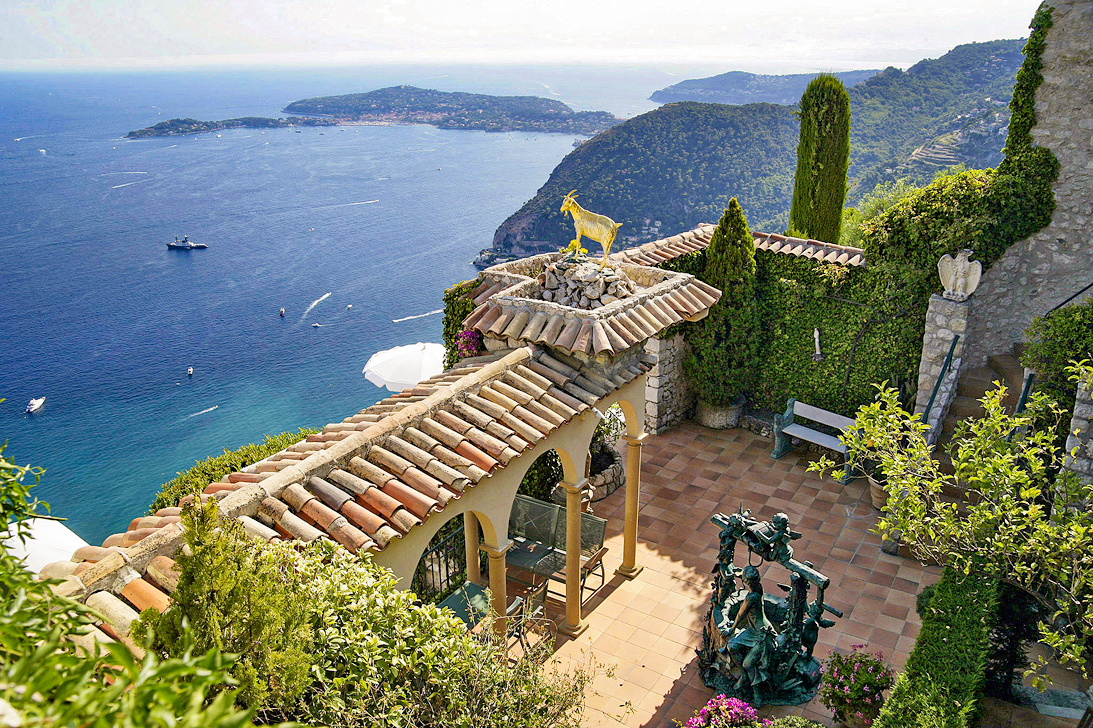
![The garden of the Chèvre d'Or Hotel © M.Strīķis - licence [CC BY-SA 3.0] from Wikimedia Commons](https://frenchmoments.eu/wp-content/uploads/2014/08/Chevre-dOr-Hotel-Gardens-©-M.Strīķis-licence-CC-BY-SA-3.0-from-Wikimedia-Commons.jpg)
The Château Eza
The château was the former residence of Prince William of Sweden. It is now a luxury hotel-restaurant with a formidable view of Eze-sur-Mer, Saint-Jean-Cap-Ferrat, the Cap d’Antibes, the Lérins islands, the Esterel and sometimes Corsica. 👉 Book your room!
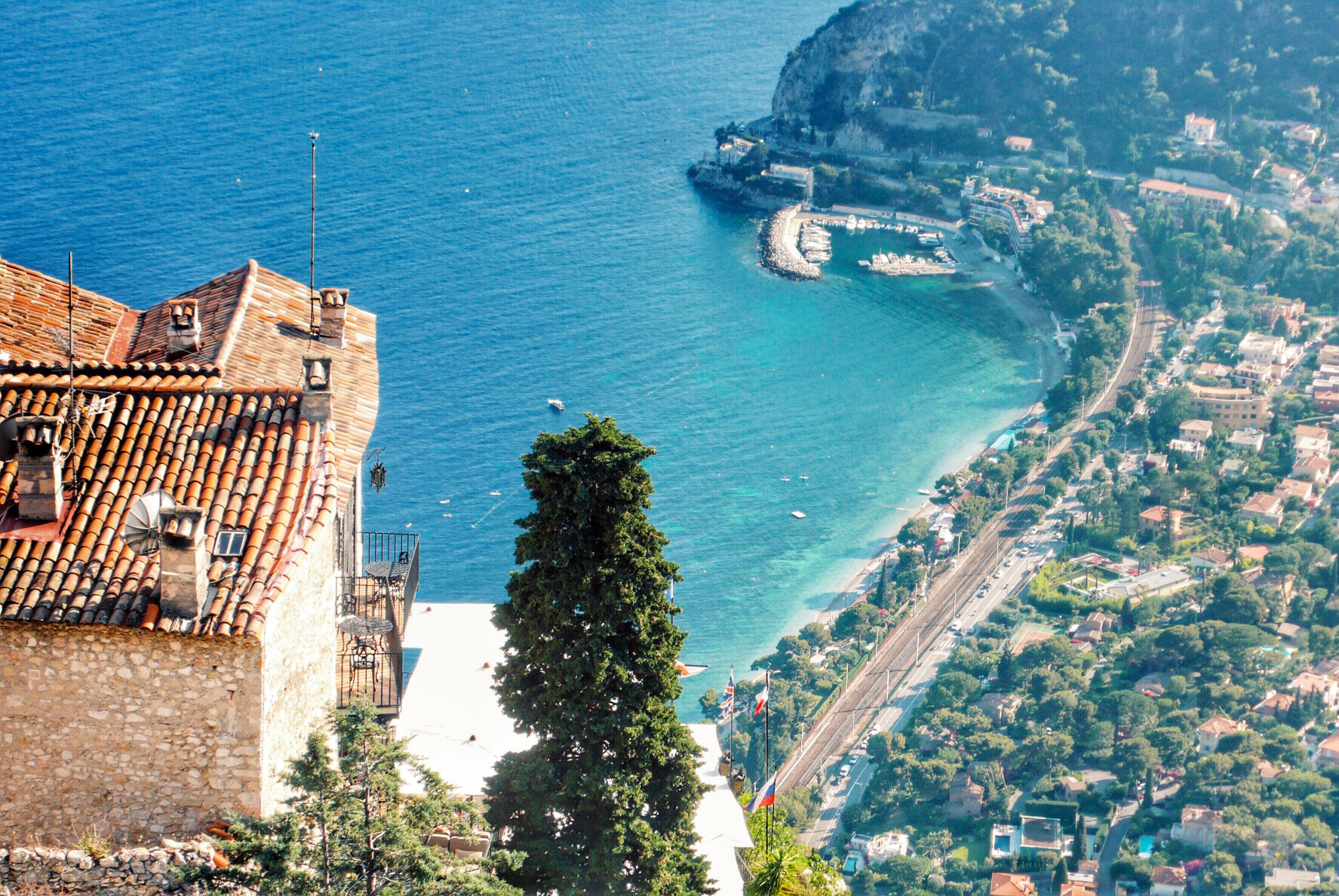
![Chateau Eza © Stuart Locke - licence [CC BY-SA 3.0] from Wikimedia Commons](https://frenchmoments.eu/wp-content/uploads/2014/08/Chateau-Eza-©-Stuart-Locke-licence-CC-BY-SA-3.0-from-Wikimedia-Commons.jpg)
Chapelle des Pénitents Blancs
The main street (Rue Principale) winds up to the Chapelle des Pénitents Blancs. Also known as Chapelle de la Sainte-Croix, this is Èze’s oldest monument, dating back to 1306.
The sanctuary held the meetings of the White Penitents, who were in charge of helping victims of the Plague. Its bell tower’s particular shape recalls when Èze was part of the Republic of Genoa.
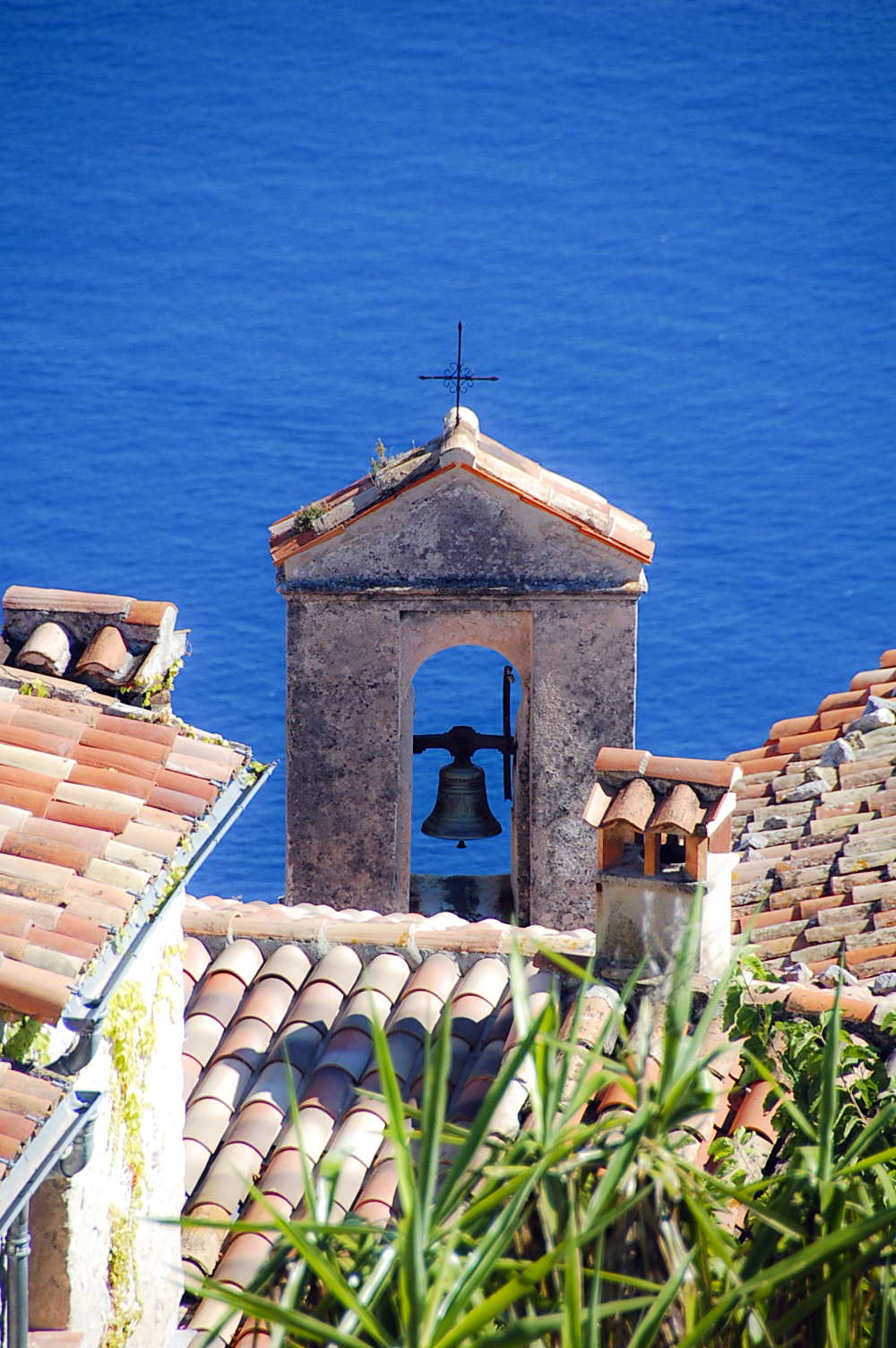
Inside are old crucifixes and statues of the Virgin dating back to the 13th and 14th centuries. On the 15th and 16th of April 1860, in this chapel, the people of Èze voted unanimously to join France.
Notre-Dame de l’Assomption Church
The light-ochre church of Notre Dame de l’Assomption was rebuilt between 1764 and 1778 on the foundation of a former sanctuary that was falling apart.
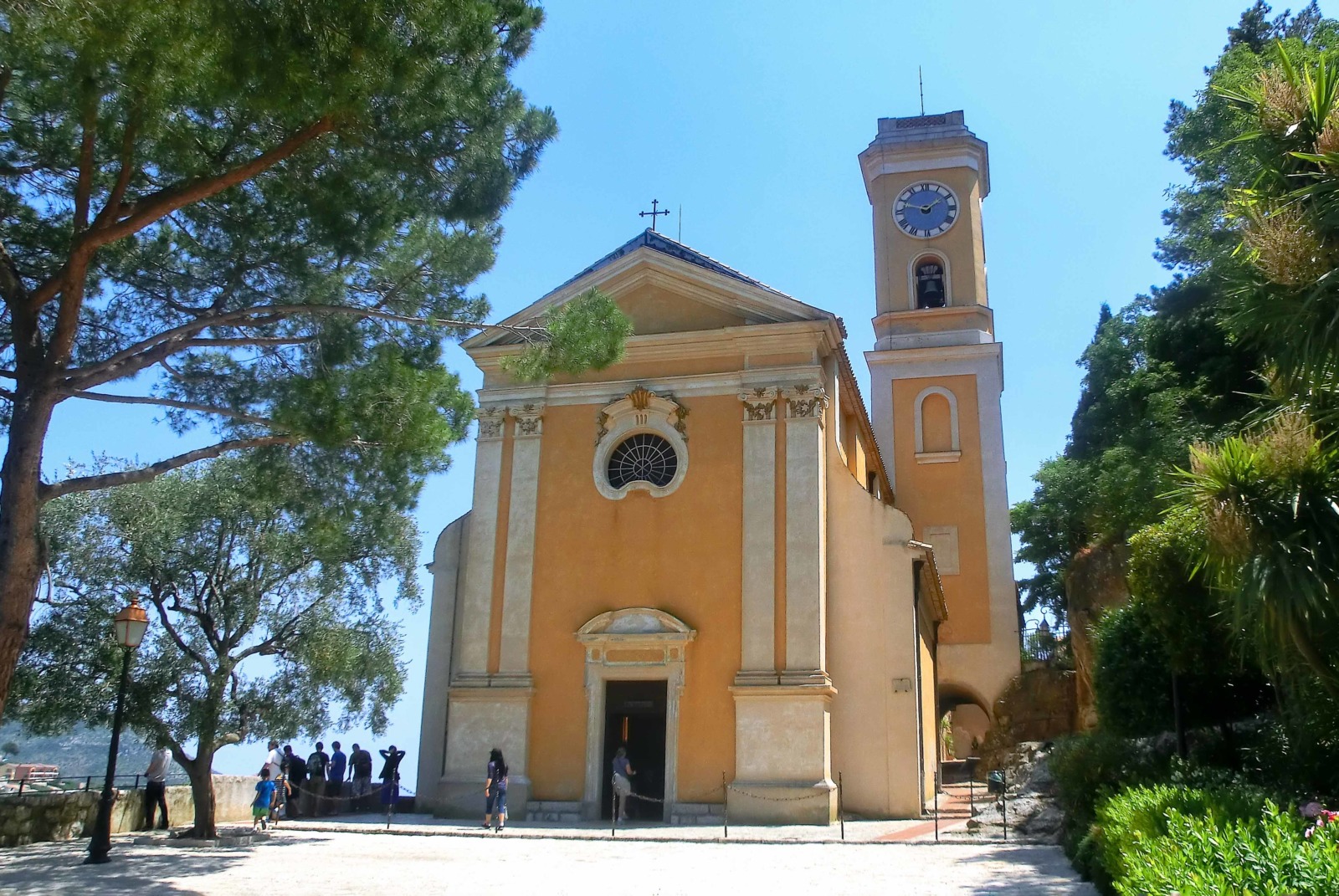
The bell tower was added in the 19th century.
Contrasting the Neo-classical façade, the church’s interior displays a rich Baroque decoration with altarpieces and trompe-l’œil windows.
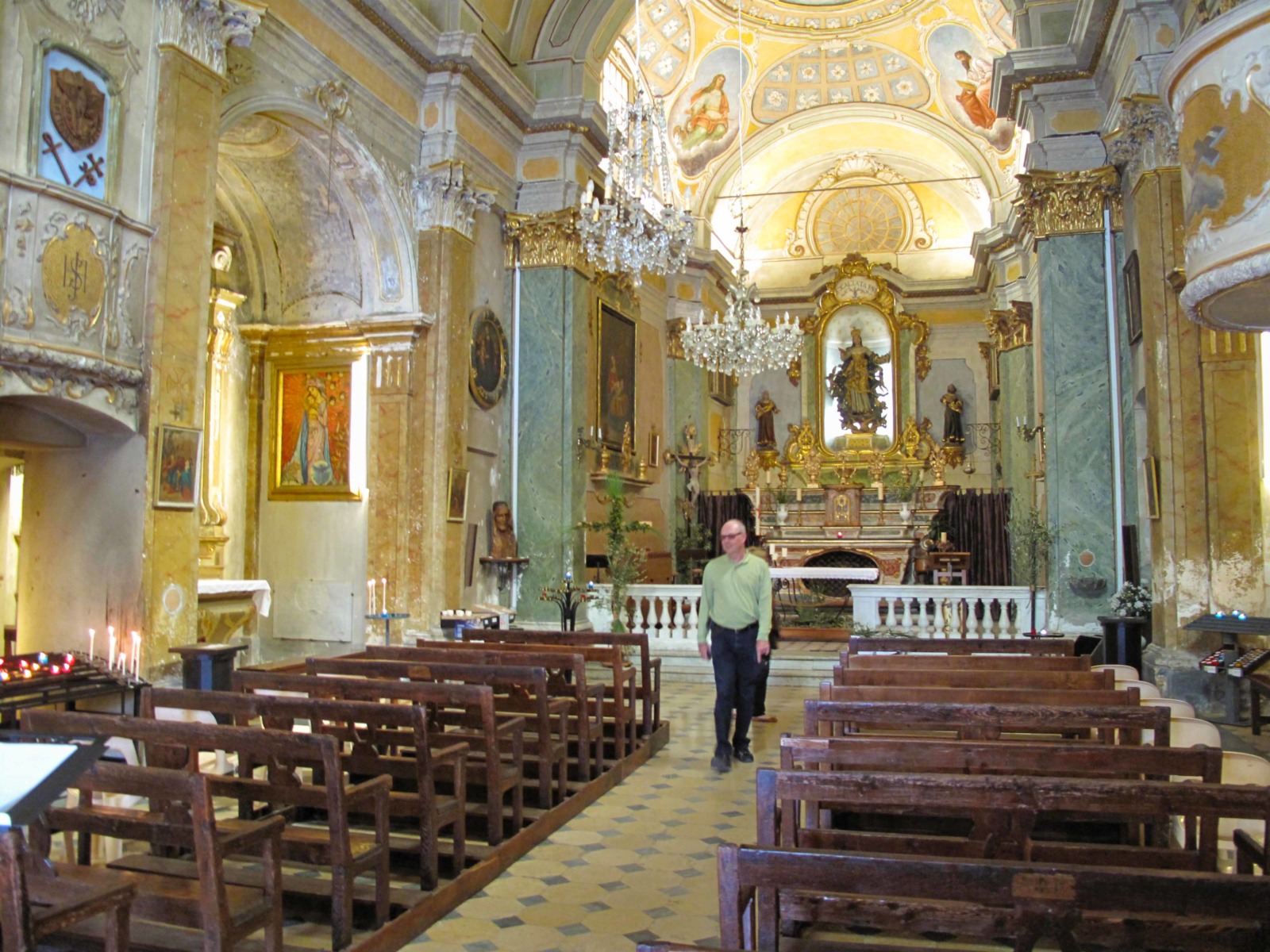
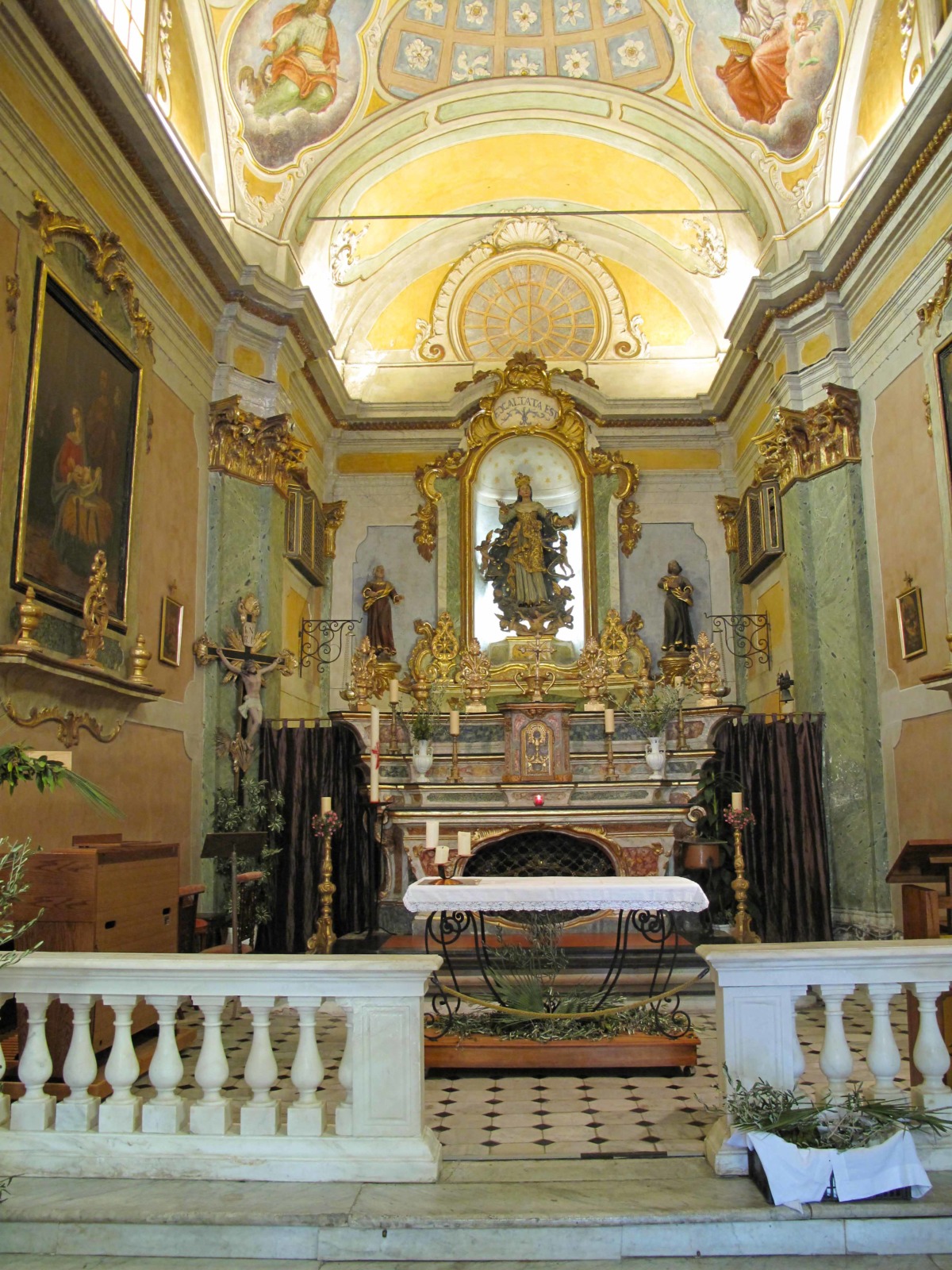
The pulpit in extravagant Baroque style:
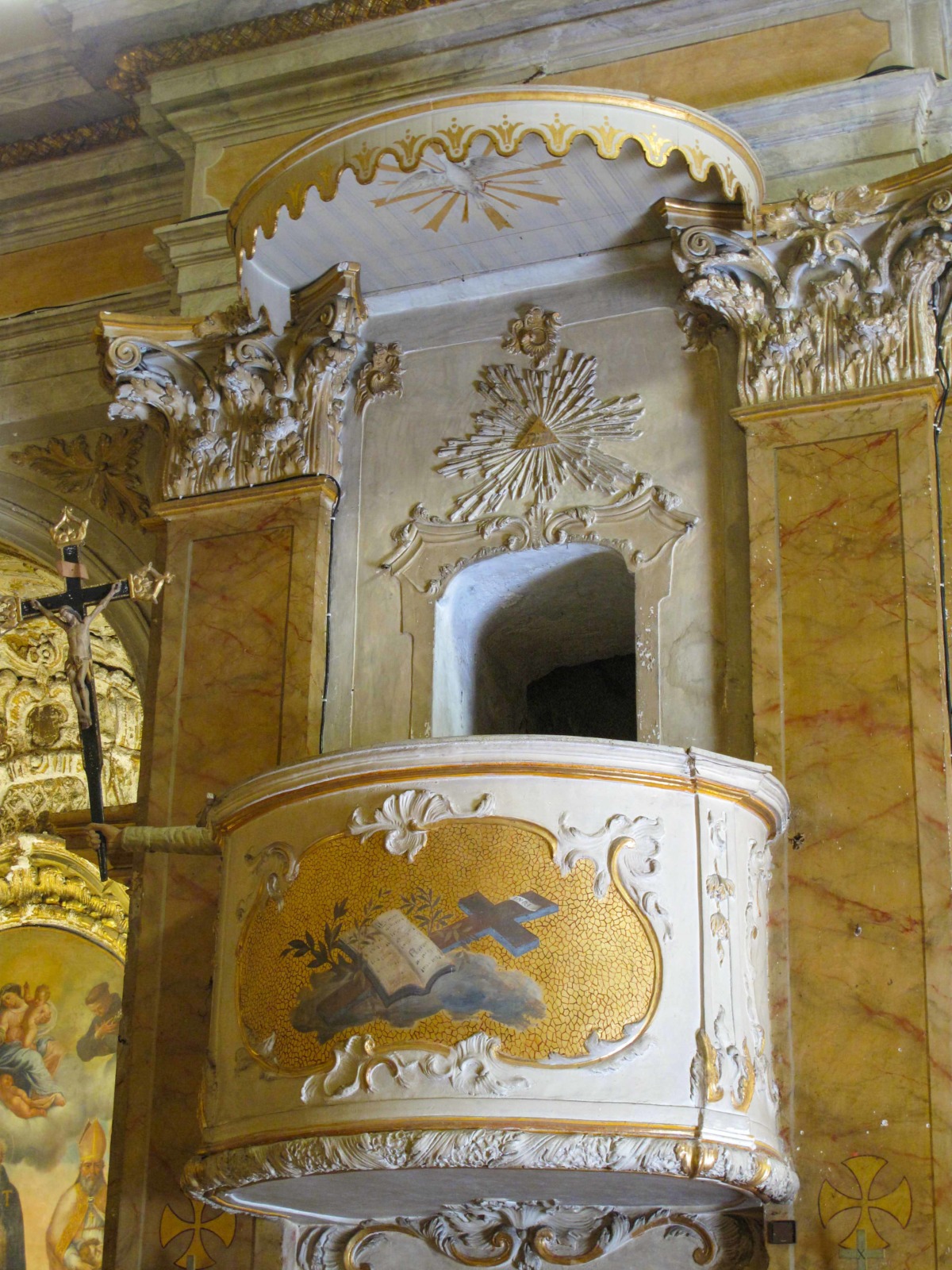
Note on one of the altarpieces a representation of the castle of Eze with, at its top, not the French flag but that of Savoy.
The French State listed the church as a Historic Monument in 1984.
Eze Castle and the Exotic Garden
At the very top of the village, the ruined castle of Eza boasts one of the most beautiful botanical gardens on the French Riviera and offers a breathtaking view of the sea and the coastline.

Mayor André Gianton and Jean Gastaud of the Exotic Garden of Monaco created the park on a steep sloping ground after World War II.
The garden contains great cacti and succulents from countries around the Mediterranean Sea, Africa, and the Americas. These plants adapted to arid or tropical climates find the Riviera’s environment favourable to their growth.
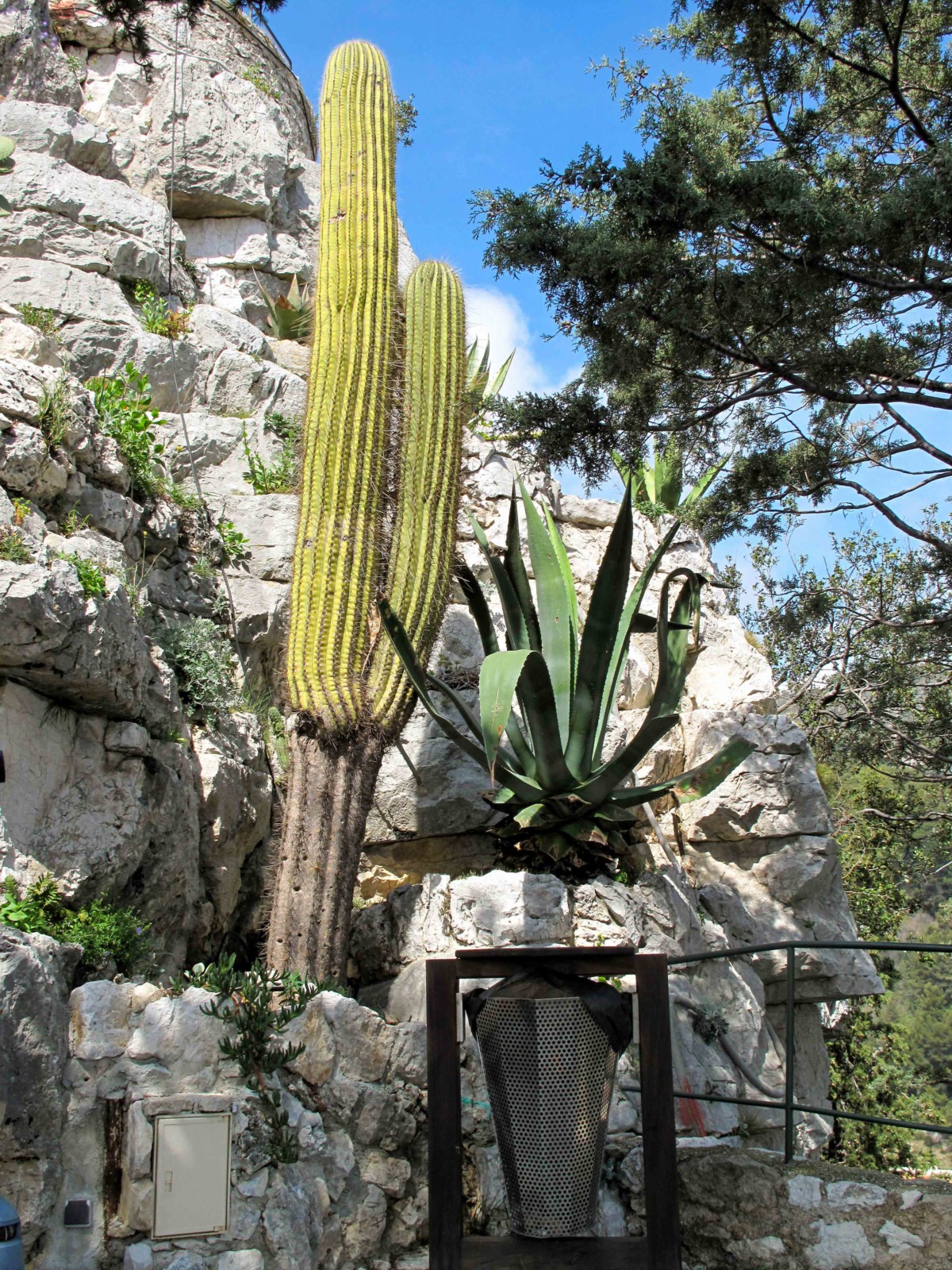
The fantastic view from the top
At an altitude of 429 m, the garden dominates straight down the sea. An orientation table locates the main famous sites on the French Riviera up to 120 km from Saint-Tropez to the Estérel Mountain range, the Lérins islands, Nice, Saint-Jean-Cap-Ferrat and the Italian shores. Under specific atmospheric conditions in winter, you can even see the shores of Corsica towards the southeast.

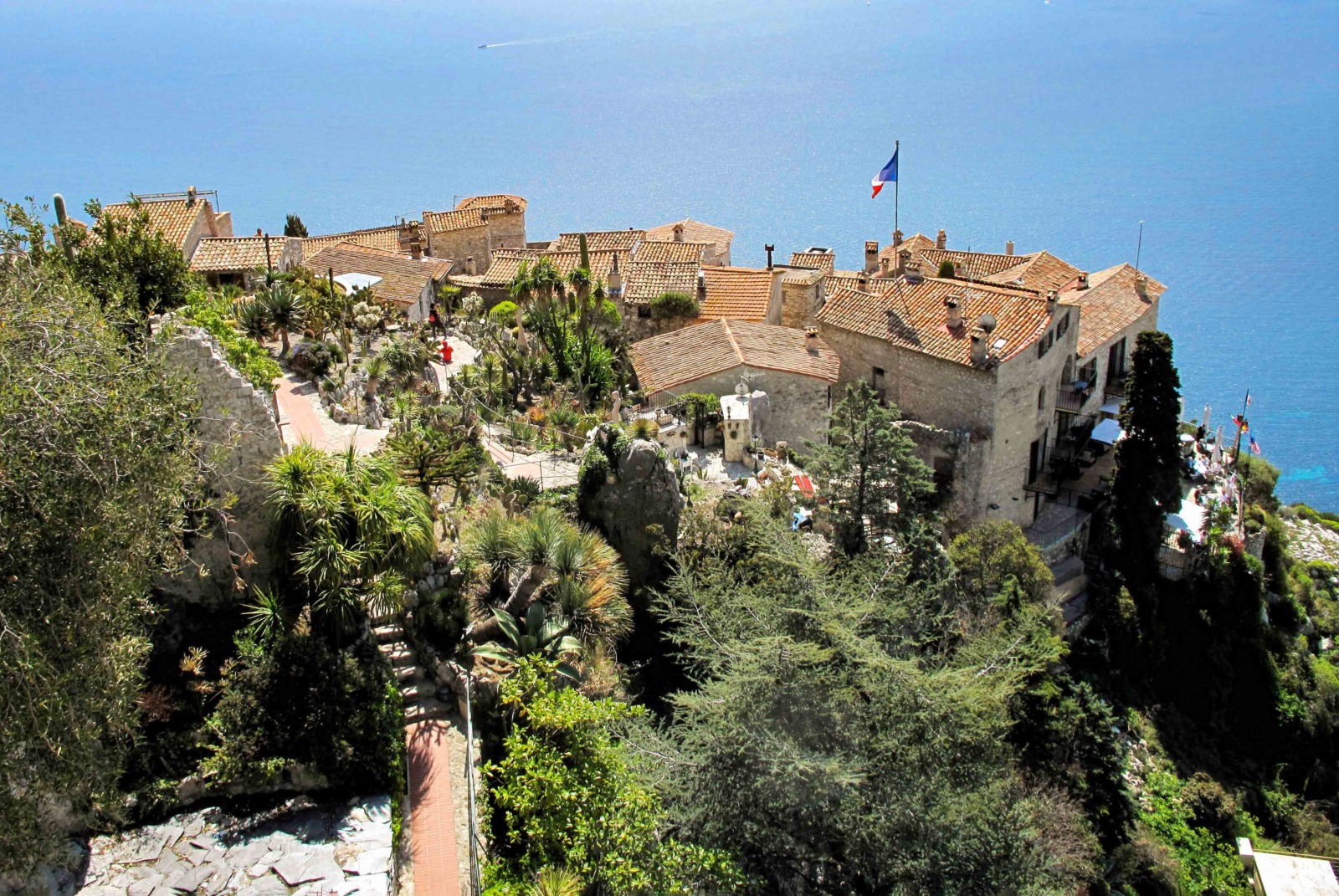
It is possible to visit the castle or what remains of it.
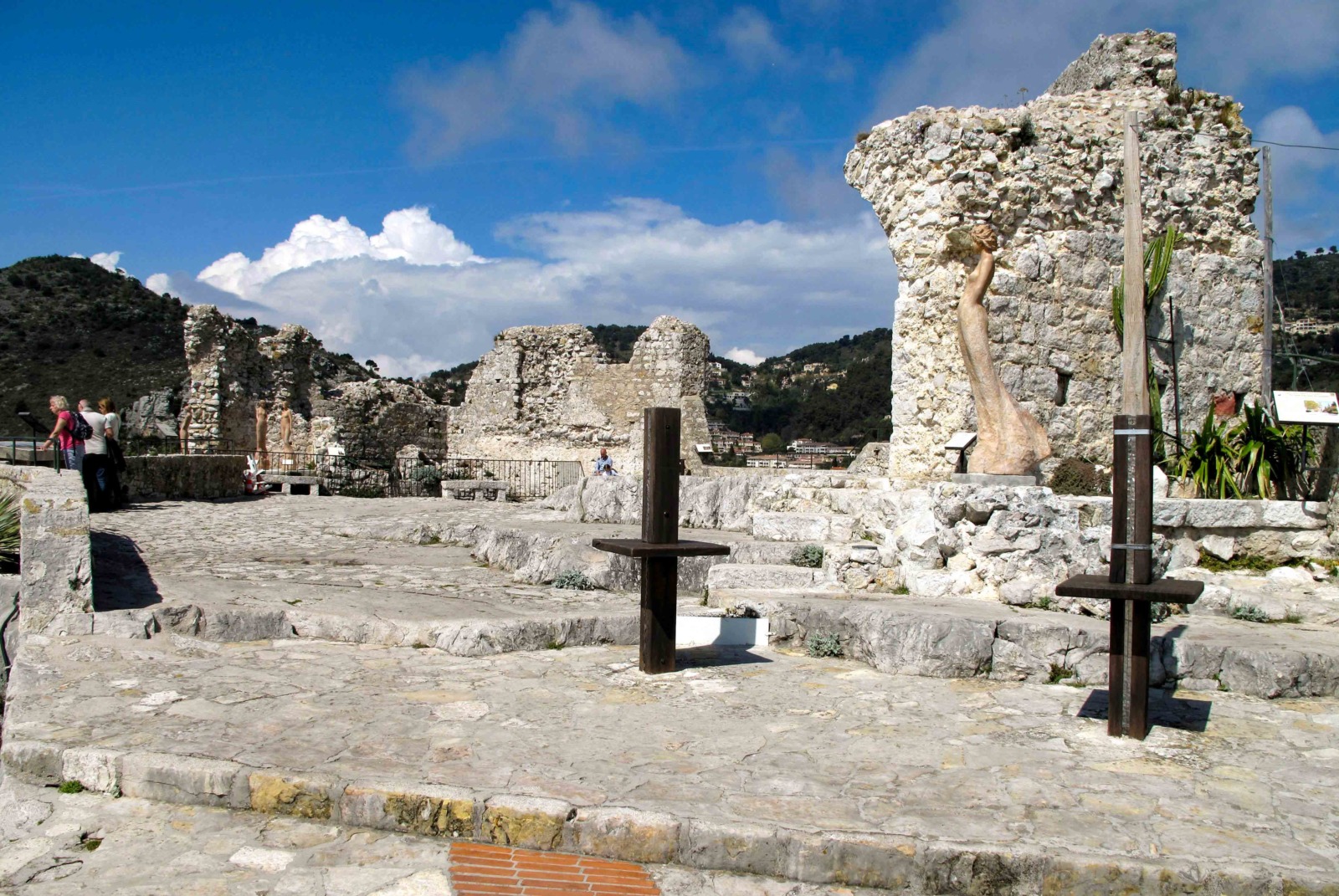
The Revère Fort
On the outskirts of Èze, the Revère Fort was part of the Séré de Rivières fortification system. Built between 1879 and 1885, it hides underground barracks linked by a vast network of tunnels.
![Fort de la Revère © Fabrice Dury - licence [CC BY-SA 3.0] from Wikimedia Commons](https://frenchmoments.eu/wp-content/uploads/2014/08/Fort-de-la-Revère-©-Fabrice-Dury-licence-CC-BY-SA-3.0-from-Wikimedia-Commons.jpg)
The site, accessible by car, has an orientation table that helps to locate the main sites on the panorama: the Mediterranean coastline, the Nice hinterland and the French Alps range of Mercantour. The view is particularly stunning in winter when the sea’s deep blue contrasts with the Maritime Alps’ snow-capped mountains.
![The magnificent view from the Revere Fort © avu-edm - licence [CC BY 3.0] from Wikimedia Commons](https://frenchmoments.eu/wp-content/uploads/2014/08/Eze-panoramic-©-avu-edm-licence-CC-BY-3.0-from-Wikimedia-Commons.jpg)
The Nietzsche’s Path (Chemin de Nietzsche)
The route length is 2 km, and the difference in altitude is 400 metres (medium difficulty).
The route includes many relatively high steps starting from the village (below the Poterne Gate). Then, the path winds through the scrubland through the rocks.
![Chemin de Nietzsche © Tangopaso - licence [CC BY-SA 3.0] from Wikimedia Commons](https://frenchmoments.eu/wp-content/uploads/2014/08/Chemin-de-Nietzsche-01-©-Tangopaso-licence-CC-BY-SA-3.0-from-Wikimedia-Commons-1.jpg)
It takes about 45 minutes for the descent and 1.5 hours for the ascent.
The path pays homage to Friedrich Nietzsche, who stayed for the first time on the French Riviera on 2 December 1883.
At that time, his morale was at its lowest. In addition to being ill, his books were not selling well. Lou Andreas-Salomé had just rejected him, and his former friend Richard Wagner had died a few months earlier. So, on the French Riviera, he rediscovered the creative emotion necessary to write.
![Eze - Chemin de Nietzsche © Solundir - licence [CC BY-SA 4.0] from Wikimedia Commons](https://frenchmoments.eu/wp-content/uploads/2014/08/Nietzsche-Path-©-Solundir-licence-CC-BY-SA-4.0-from-Wikimedia-Commons-1.jpg)
![Eze - Rocks around Path of Nietzsche © Solundir - licence [CC BY-SA 4.0] from Wikimedia Commons](https://frenchmoments.eu/wp-content/uploads/2014/08/Eze-Nietzsche-Path-©-Solundir-licence-CC-BY-SA-4.0-from-Wikimedia-Commons-1.jpg)
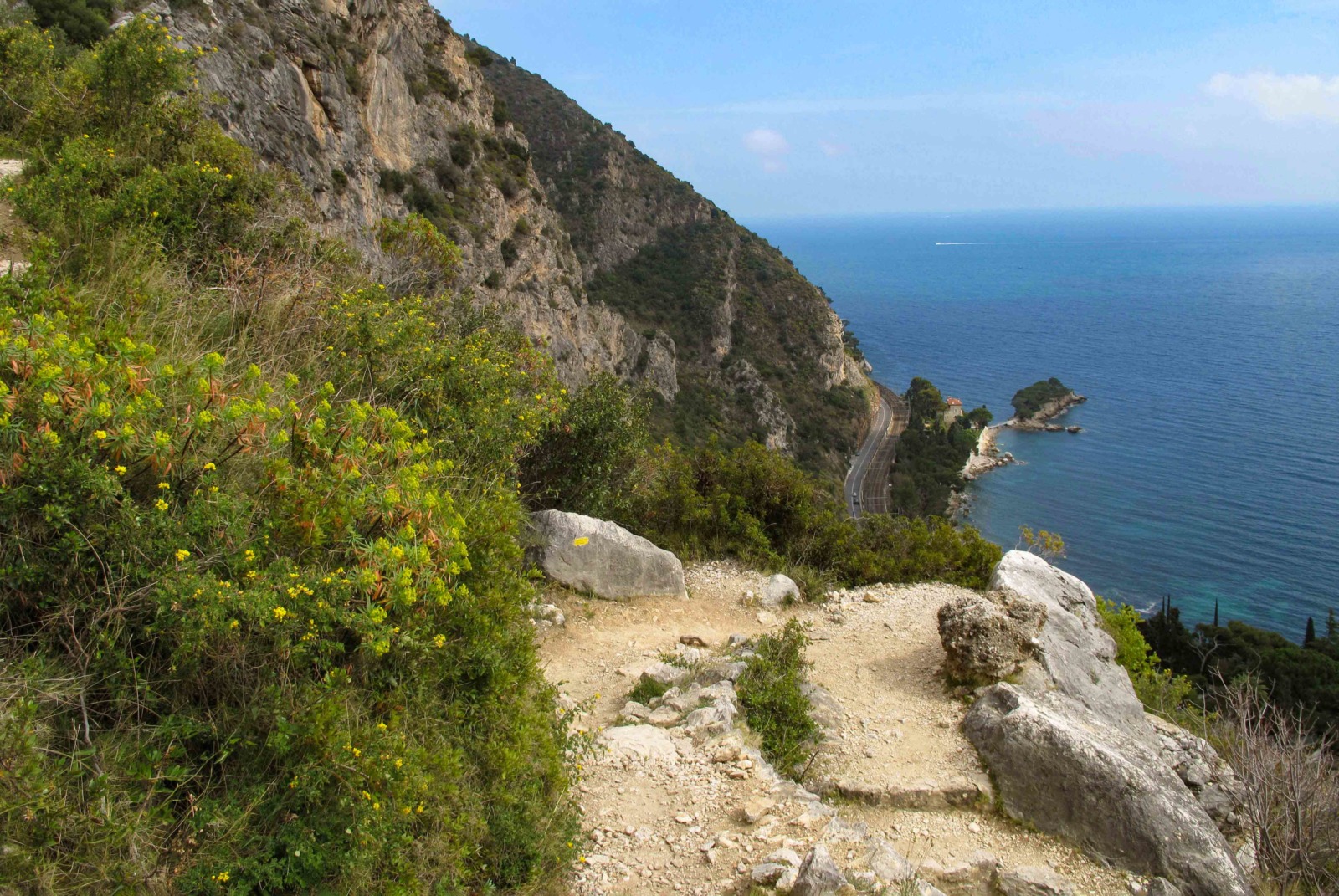
![The seafront from the Chemin de Nietzsche © Solundir - licence [CC BY-SA 4.0] from Wikimedia Commons](https://frenchmoments.eu/wp-content/uploads/2014/08/Eze-Nietzsche-Path-03-©-Solundir-licence-CC-BY-SA-4.0-from-Wikimedia-Commons-1.jpg)
![The coastline from the Chemin de Nietzsche © Tangopaso - licence [CC BY-SA 3.0] from Wikimedia Commons](https://frenchmoments.eu/wp-content/uploads/2014/08/Chemin-de-Nietzsche-03-©-Tangopaso-licence-CC-BY-SA-3.0-from-Wikimedia-Commons-1.jpg)
The Fragonard Shop and factory laboratory
Before leaving the village, don’t miss the fantastic Fragonard shop to buy soaps, scented candles and other Provençal delicacies.
![Fragonard in Èze © Georges Jansoone - licence [CC BY 3.0] from Wikimedia Commons](https://frenchmoments.eu/wp-content/uploads/2014/08/Fragonard-in-Èze-©-Georges-Jansoone-licence-CC-BY-3.0-from-Wikimedia-Commons.jpg)
You can take a free tour of the Fragonard factory with a guide trained by a professional perfume maker who knows all about the history of the trade. After exploring the manufacturing techniques and the history of the precious fluids, you will test your nose with a free olfactory game at the end of the tour.
The perfumery is located just outside the historic village (no need to take the car to get there if you are already parked, you can walk there).
How to get to Eze
Situated between Nice and Monaco, the village of Èze is easily accessible, although traffic during July and August and weekends are usually hefty.

By car
From Nice (11 km) or Monaco (7 km), the hilltop village of Èze is accessible by the Moyenne Corniche road (D6007). The nearest motorway exit on the A8 is number 57 (La Turbie).
By train
There is a train station at Èze-Bord-de-Mer on the Nice-Menton TER line. A bus connects to the hilltop village.
By air
Nice, France’s third airport after Paris CDG and Orly, is only 18 km from Èze.
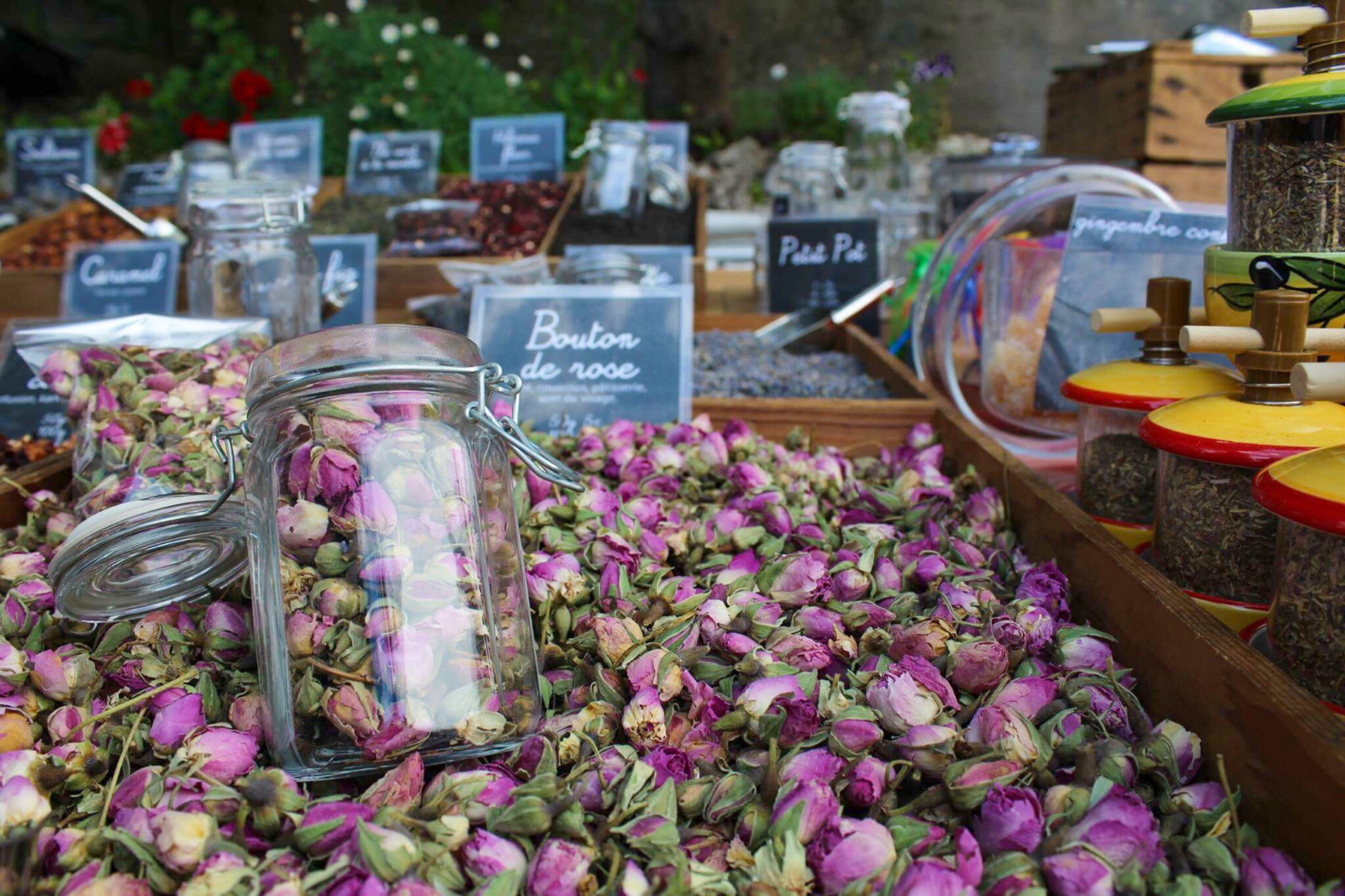
English-French Vocabulary
(f) for féminin, (m) for masculin, (adj) for adjective and (v) for verbs
- castle = château (m)
- county = comté (m)
- exotic garden = jardin exotique (m)
- French Alps = Alpes françaises (f,p)
- French Riviera = Côte d’Azur (f)
- House of Savoy = Maison de Savoie (f)
- Mediterranean Sea = Mer Méditerranée (f)
- mountain = montagne (f)
- perched village = village perché (m)
- Prealps = Préalpes (f,p)
- village = village (m)
![Eze © avu-edm - licence [CC BY 3.0] from Wikimedia Commons](https://frenchmoments.eu/wp-content/uploads/2014/08/Eze-©-avu-edm-licence-CC-BY-3.0-from-Wikimedia-Commons.jpg)
Pin it for later!

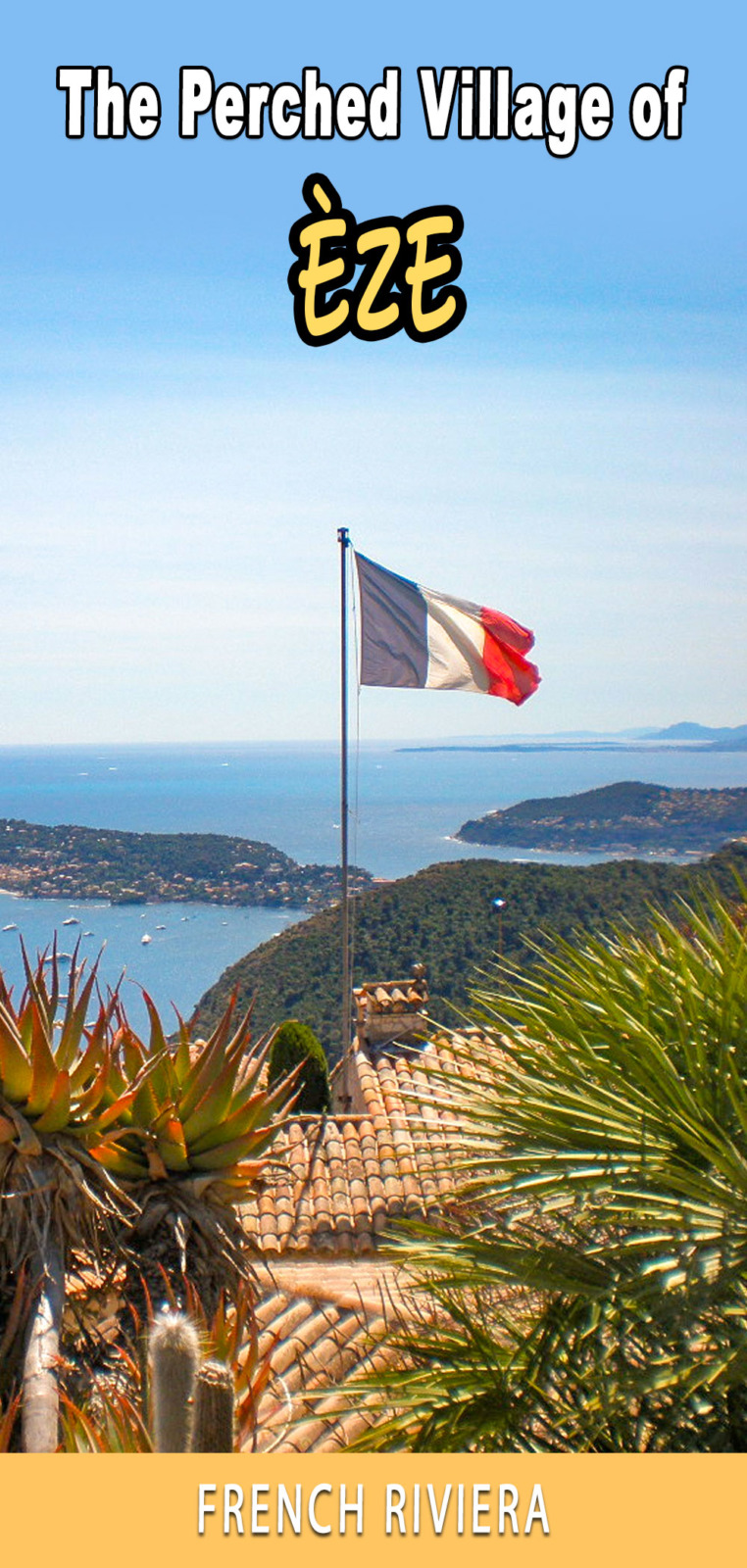
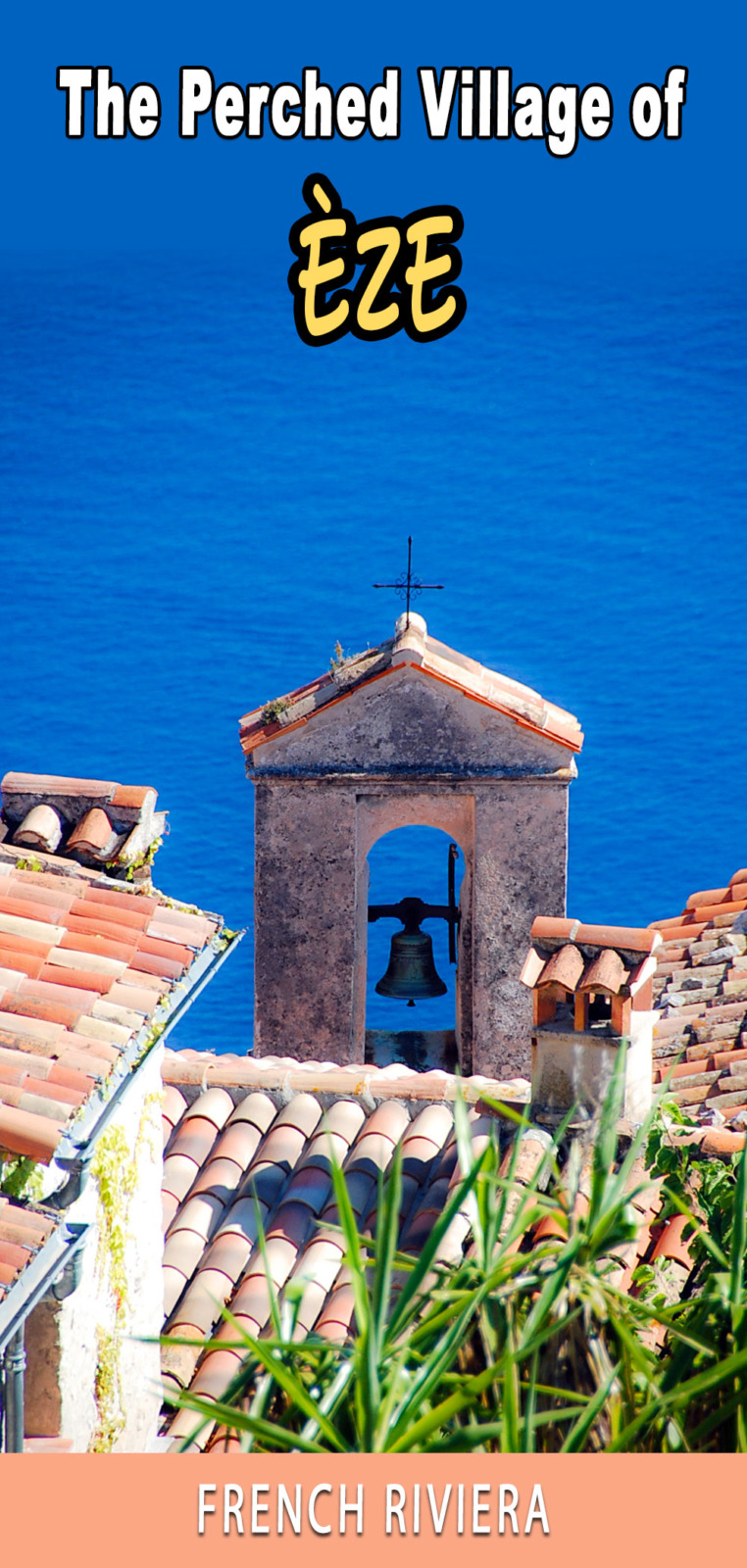
Featured image: Jimi Magic (Public Domain via Wikimedia Commons)


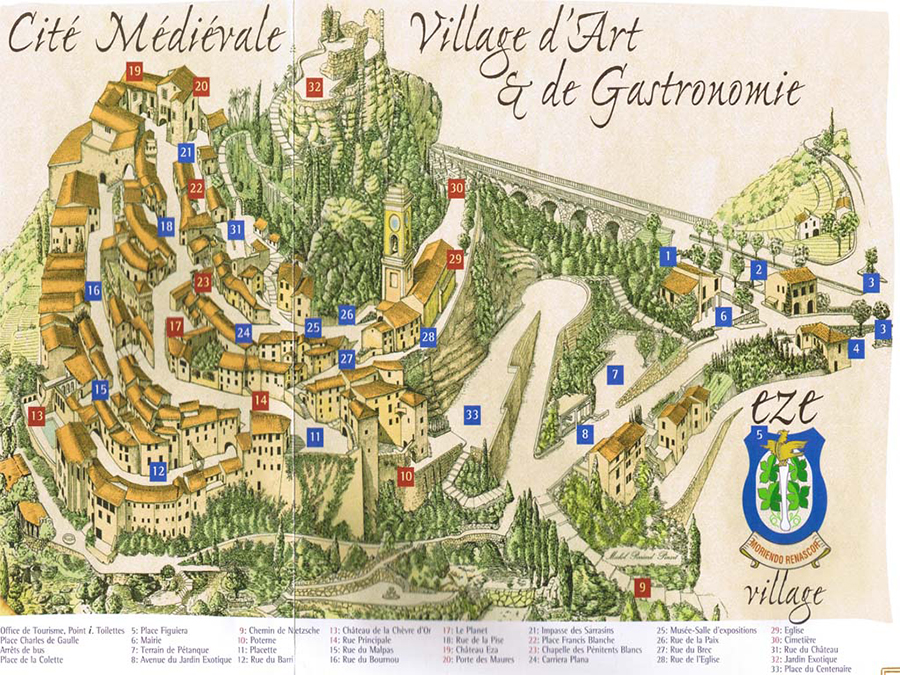

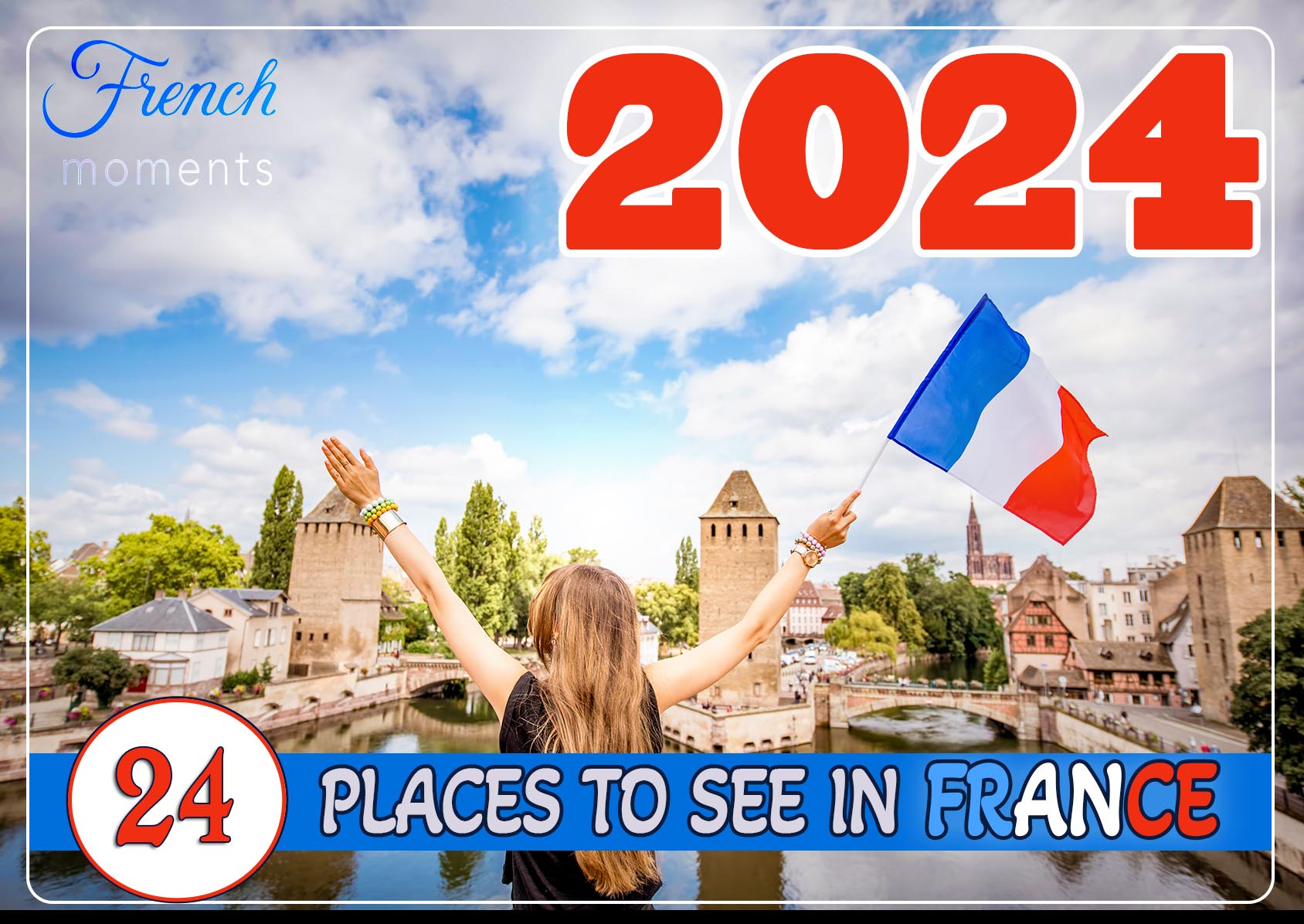
Great post Pierre!
Thank you Michael! 🙂